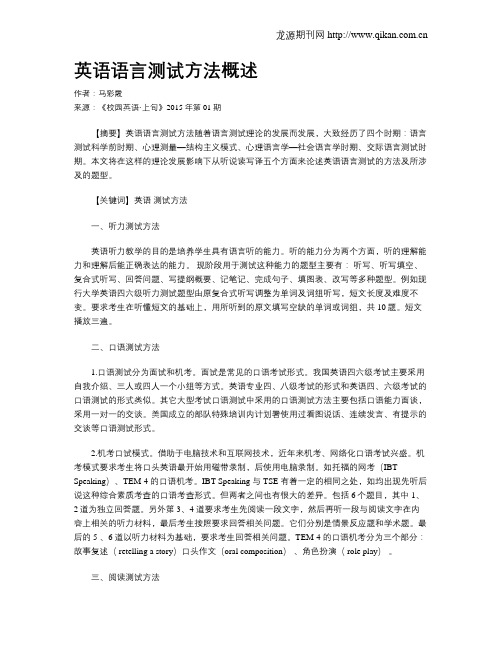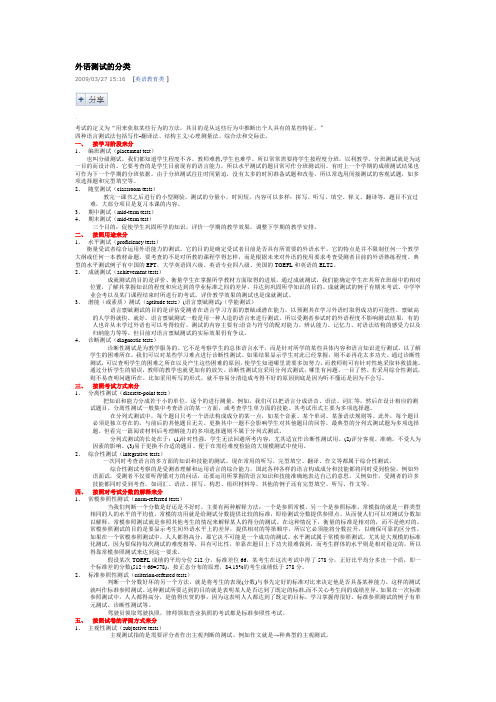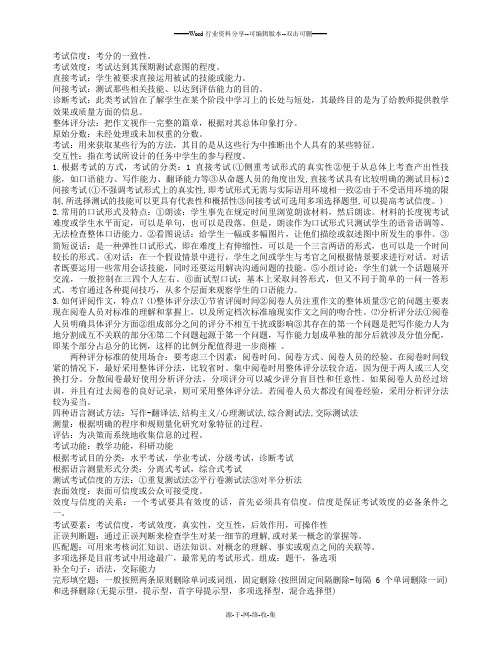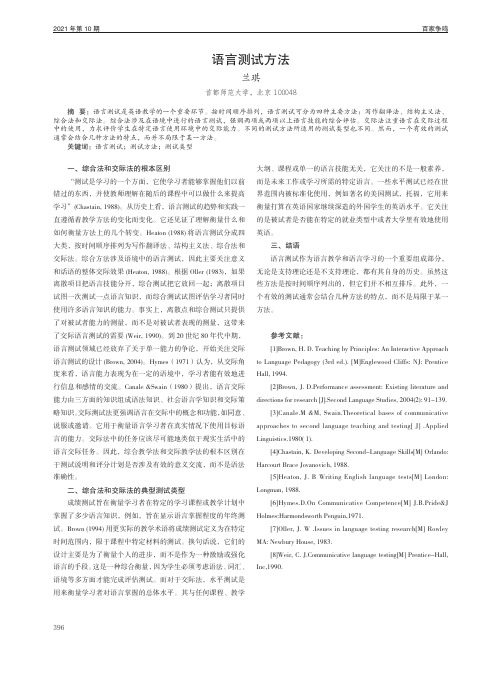四种英语语言测试法
外语测试的分类

外语测试的分类2009/03/27 15:16[英语教育类 ]考试的定义为“用来获取某些行为的方法,其目的是从这些行为中推断出个人具有的某些特征。
”四种语言测试法包括写作-翻译法、结构主义/心理测量法、综合法和交际法。
一、按学习阶段来分1、编班测试(placement test)也叫分级测试。
我们都知道学生程度不齐。
教师难教,学生也难学。
所以常常需要将学生按程度分班,以利教学。
分班测试就是为这一目的而设计的。
它要考查的是学生目前现有的语言能力,所以水平测试的题目常可作分班测试用。
有时上一个学期的成绩测试结果也可作为下一个学期的分班依据。
由于分班测试往往时间紧迫,没有太多的时间准备试题和改卷,所以常选用间接测试的客观试题,如多项选择题和完型填空等。
2、随堂测试(classroom tests)教完一课书之后进行的小型测验。
测试的分量小,时间短,内容可以多样:拼写、听写、填空、释义、翻译等。
题目不宜过难,大部分项目是复习本课的内容。
3、期中测试(mid-term tests)4、期末测试(mid-term test)三个目的:促使学生巩固所学的知识,评价一学期的教学效果,调整下学期的教学安排。
二、按照用途来分1、水平测试(proficiency tests)衡量受试者综合运用外语能力的测试。
它的目的是确定受试者目前是否具有所需要的外语水平。
它的特点是并不限制任何一个教学大纲或任何一本教材命题。
要考查的不是对所教的课程学得怎样,而是根据未来对外语的使用要求考查受测者目前的外语熟练程度。
典型的水平测试例子有中国的EPT,大学英语四六级、英语专业四八级、美国的TOEFL和英语的ELTS。
2、成就测试(achievement tests)成就测试的目的是评价、衡量学生在掌握所学教材方面取得的进展。
通过成就测试,我们能确定学生在其所在班级中的相对位置,了解其掌握知识的程度和应达到的学业标准之间的差异,并达到巩固所学知识的目的。
语言测试理论

语言测试理论(Language Assessment)定义(definition)Anastasi (1982)认为“测试实质上是对受试者的某种能力所做的客观的标准化测量”。
Carroll 则认为测试是一套程序,旨在诱发受试者的行为反应, 并以此推导出他的相关特征(a procedure designed to elicit certain behavior from which one can make inferences about certain characteristics of an individual)。
二、英语语言测试理论(一)英语语言测试类型Hughes(1989:9-19)依据测试目的、测试方法和方式、测试题型、测试成绩判别标准和判卷标准进行分类, 将英语测试分为五大类。
1.依据测试目的进行分类( 1 )水平测试(proficiency test) 语言水平测试是为了测试人们语言能力而设计的。
( 2 )学业成绩测试(achievement test)学业成绩测试是用来考查被试在学习英语某一阶段或最终阶段的成功程度。
(3)诊断测试(diagnostic test):诊断测试是用来鉴别学生的优势和不足之处,用来确定什么样的教学是必要的。
(4)能力测试(aptitude test)能力测试不以任何教学大纲为基础,目的在于检验测试者是否具备了学习某种语言的潜力。
2.依据测试方法和方式进行分类(1)直接测试(direct testing)直接考察学生某一方面语言能力的测试称为直接测试。
(2)间接测试(indirect testing)间接测试即通过测试某一技能所具备某种能力来发现学生这方面的语言能力。
3.依据测试题型进行分类:分散点测试指每次只测试一个项目的测试,每道试题只测试某一特定的语法结构等,属于间接测试。
4.依据测试成绩判别标准进行分类(1)常模参考型测试(norm-referenced testing)(2)标准参考型测试(criterion-referenced testing)以某种特定的语言能力标准作为判别标准的测试称为标准参考测试。
英语语言测试方法概述

英语语言测试方法概述作者:马彩霞来源:《校园英语·上旬》2015年第01期【摘要】英语语言测试方法随着语言测试理论的发展而发展,大致经历了四个时期:语言测试科学前时期、心理测量—结构主义模式、心理语言学—社会语言学时期、交际语言测试时期。
本文将在这样的理论发展影响下从听说读写译五个方面来论述英语语言测试的方法及所涉及的题型。
【关键词】英语测试方法一、听力测试方法英语听力教学的目的是培养学生具有语言听的能力。
听的能力分为两个方面,听的理解能力和理解后能正确表达的能力。
现阶段用于测试这种能力的题型主要有:听写、听写填空、复合式听写、回答问题、写提纲概要、记笔记、完成句子、填图表、改写等多种题型。
例如现行大学英语四六级听力测试题型由原复合式听写调整为单词及词组听写,短文长度及难度不变。
要求考生在听懂短文的基础上,用所听到的原文填写空缺的单词或词组,共10题。
短文播放三遍。
二、口语测试方法1.口语测试分为面试和机考。
面试是常见的口语考试形式。
我国英语四六级考试主要采用自我介绍、三人或四人一个小组等方式。
英语专业四、八级考试的形式和英语四、六级考试的口语测试的形式类似。
其它大型考试口语测试中采用的口语测试方法主要包括口语能力面谈,采用一对一的交谈。
美国成立的部队特殊培训内计划署使用过看图说话、连续发言、有提示的交谈等口语测试形式。
2.机考口试模式。
借助于电脑技术和互联网技术,近年来机考、网络化口语考试兴盛。
机考模式要求考生将口头英语最开始用磁带录制,后使用电脑录制。
如托福的网考(IBT Speaking)、TEM-4 的口语机考。
IBT Speaking 与TSE 有着一定的相同之处,如均出现先听后说这种综合素质考查的口语考查形式。
但两者之间也有很大的差异。
包括6个题目,其中1、2道为独立回答题。
另外第3、4 道要求考生先阅读一段文字,然后再听一段与阅读文字在内容上相关的听力材料,最后考生按照要求回答相关问题。
英语口语测试方法及分析

英语口语测试方法及分析英语口语测试是一种评估学生口头表达能力的方法。
通过测试,教师可以了解学生在听、说、读、写等方面的水平,并能针对性地帮助学生提高口语表达能力。
下面将介绍英语口语测试的方法及分析。
一、英语口语测试的方法1. 面试法:教师根据课程要求,针对学生的口语能力进行面对面的交流。
可以进行一对一的测试,也可以进行小组活动测试。
通过对话、问答、演讲等形式,考察学生的听力、口语表达、语法运用等能力。
2. 角色扮演法:教师设定各种情境,要求学生在特定的角色身份下进行对话。
模拟在餐厅点餐、在商店购物、在旅行中寻求帮助等情境。
通过表演角色扮演的方式,考察学生的口语表达和语言应用能力。
3. 录音法:教师提前准备好提问内容,要求学生现场回答,并录音保存。
然后教师可以在后续时间里,对录音进行听力评估和分析,了解学生的口语表达能力和语音语调等方面的问题。
二、英语口语测试的分析1. 词汇量:通过学生在口语测试中使用的词汇量进行分析。
可评估学生的词汇量是否丰富,是否能准确地使用词语。
3. 表达能力:通过学生在口语测试中的表达能力进行分析。
包括发音清晰度、语音语调、语速等方面的评估。
4. 回答问题的准确性:通过学生的回答问题的准确性进行分析。
可以评估学生是否能理解问题的意思,是否能正确回答问题。
5. 听力理解:通过学生在口语测试中的听力理解能力进行分析。
可以评估学生是否能准确理解教师的提问或其他学生的发言内容。
三、英语口语测试的建议1. 多样化测试形式:可以通过多样化的测试形式,如面试法、角色扮演法、录音法等,以充分考察学生的口语能力和语言应用能力。
2. 给予及时反馈:在测试完毕后,及时给予学生反馈,指出其口语表达中存在的问题,并给予建议和指导,帮助学生改进。
3. 引导学生练习:通过测试结果,为学生指定口语训练的重点和方向,并引导学生进行口语练习,提高口语表达能力。
4. 鼓励积极参与:在测试过程中,鼓励学生积极参与,提高他们的口语自信心和表达能力。
外语测试的分类

外语测试的分类2009/03/27 15:16[英语教育类 ]考试的定义为“用来获取某些行为的方法,其目的是从这些行为中推断出个人具有的某些特征。
”四种语言测试法包括写作-翻译法、结构主义/心理测量法、综合法和交际法。
一、按学习阶段来分1、编班测试(placement test)也叫分级测试。
我们都知道学生程度不齐。
教师难教,学生也难学。
所以常常需要将学生按程度分班,以利教学。
分班测试就是为这一目的而设计的。
它要考查的是学生目前现有的语言能力,所以水平测试的题目常可作分班测试用。
有时上一个学期的成绩测试结果也可作为下一个学期的分班依据。
由于分班测试往往时间紧迫,没有太多的时间准备试题和改卷,所以常选用间接测试的客观试题,如多项选择题和完型填空等。
2、随堂测试(classroom tests)教完一课书之后进行的小型测验。
测试的分量小,时间短,内容可以多样:拼写、听写、填空、释义、翻译等。
题目不宜过难,大部分项目是复习本课的内容。
3、期中测试(mid-term tests)4、期末测试(mid-term test)三个目的:促使学生巩固所学的知识,评价一学期的教学效果,调整下学期的教学安排。
二、按照用途来分1、水平测试(proficiency tests)衡量受试者综合运用外语能力的测试。
它的目的是确定受试者目前是否具有所需要的外语水平。
它的特点是并不限制任何一个教学大纲或任何一本教材命题。
要考查的不是对所教的课程学得怎样,而是根据未来对外语的使用要求考查受测者目前的外语熟练程度。
典型的水平测试例子有中国的EPT,大学英语四六级、英语专业四八级、美国的TOEFL和英语的ELTS。
2、成就测试(achievement tests)成就测试的目的是评价、衡量学生在掌握所学教材方面取得的进展。
通过成就测试,我们能确定学生在其所在班级中的相对位置,了解其掌握知识的程度和应达到的学业标准之间的差异,并达到巩固所学知识的目的。
英语口语自我评估方法总结

英语口语自我评估方法总结英语口语的提高对于我们来说非常重要,而自我评估是衡量自己口语水平和进步的有效方法之一。
下面我将总结几种常用的英语口语自我评估方法,希望能对大家有所帮助。
一、录音自我评估法录音自我评估法是指通过录音并反复听取自己的口语表达来评估自己的口语水平。
具体操作步骤如下:1.选择一个话题或一个对话材料,准备好录音设备。
2.按照预设的时间,自由地表达自己关于该话题或对话材料的观点。
3.录音结束后,听取自己的录音并仔细评估。
4.对比录音中的表达和标准口语范例,找出自己的不足之处。
5.记录自己的口语问题,并设定改进计划。
使用录音自我评估法的好处是能够客观地听取自己的表达,发现自己的问题并及时进行改进。
同时,通过反复听取自己的录音,还可以提高自己的听力理解能力和口语表达能力。
二、口语测试自我评估法口语测试自我评估法是指通过参加口语测试并分析测试结果来评估自己的口语水平。
具体操作步骤如下:1.选择一种标准的口语测试形式,如面试、小组讨论等。
2.按照测试要求,参加口语测试。
3.在测试完成后,对自己的表现进行评估和分析。
4.根据评估结果,找出自己的不足之处。
5.制定相应的口语训练计划,并注重改进自己在测试中出现的问题。
口语测试自我评估法的好处是能够模拟真实的口语交流情境,更好地发现自己的不足之处,并有针对性地进行改进。
通过参加口语测试,还可以提高自己的口语应对能力和自信心。
三、语音纠正自我评估法语音纠正自我评估法是指通过纠正自己的语音发音错误来评估自己的语音水平。
具体操作步骤如下:1.选择一篇短文或单词列表。
2.仔细阅读或朗读短文,注意语音发音。
3.录音并重复播放自己的发音。
4.对比标准的发音和自己的发音,找出差异。
5.反复练习,纠正发音错误。
语音纠正自我评估法的好处是能够细致地纠正自己的语音发音问题,提高口语的准确度和流畅度。
通过不断地发现和纠正发音错误,可以逐渐培养出良好的语音习惯。
四、情景对话自我评估法情景对话自我评估法是指通过模拟真实的口语交流情境来评估自己的口语表达能力。
课本内容简单整理

Topics1. Introduction to language testing2. Functions of testing & different types of tests3. Criteria of tests4. Test specification5. Test tasks6. Testing reading comprehension7. Testing listening comprehension8. Testing the writing skills9. Oral production tests10. Test design & implementation11. Interpreting test scores12. Analysis of test scores (1)13. Analysis of test scores (2)14-16. Statistics analysis (e.g. T-test, correlation analysis)1. Four approaches of English testing:四种英语语言测试法1)写作-翻译法the essay-translation approach2)结构主义/心理测试法the structuralist-psychometric approach3)综合测试法the integrative approach:context4)交际测试法the communicative approach: use2. Measurement: process, quantitativeTest: method, quantitativeAssessment: a term often used interchangeably with testing, but it can be used more broadly to encompass the gathering of educational data. …interview, case study, questionnaire, and observation are often used. (王振亚,2009)Evaluation: test & value judgement, qualitative测量指的是根据明确的程序和规则量化研究对象特征的过程;考试是用来获取某些行为的方法,目的是从这些行为中推断出个人具有的某些铁证,与测量不同的是,考试是一种具体为获取某一行为样本而量身定做的定量分析方法;评估是为决策而系统地手机信息的过程,侧重信息收集和信息的系统性,涵盖范围广,信息来源没有局限性。
浅析英语测试类型

2 E 。教育部考试 中心和英 国剑桥大 阅读成绩有 整分有半分 ;写作和口语只以整分 . BC 3 学考试委员会合作 ,为适应中国改革 开放 的需 计算。 要, 双方协议于 19 年起在中国合作举办商务 93 33GR 。 - E 美国研究生入学考试资格考试 , 英 语 证 书 ( U I E S NG IH E T  ̄一 由美 国教育考试服务处主办 。每年在世界许 多 B SN S E LS C R I C1 ) A I 考试。 系列考试是一项水平考试 , E 该 根据 地方举 行。适用于除 了法律 ( 需参加 L A s T考 商务工作的实 际需要和商务工作人员业务水平 试 ) 与商业 ( 参加 G T考) 需 MA 以外 的各种学科 的需要 , 对考生在商务和一般 生活环境下使用 与专业 的研究生考试 。G E考试分两种一般 能 R 英语 的能力从 听、 读 、 四个方面 进行 全面 力 或 称倾 向性 测 验 (eea t t A t d 说、 写 G nrl e 或 pi e s t u 考查 ,对成绩及格者提供由英 国剑桥大学考试 Ts ;专业测 验或称高级测验 (ujc T s或 et ) S bet et 委员会颁发成绩证书 。 证书在英国、 英联邦各国 A vn e et dacd T ) s 。平 常 所说 GR E考 试 都是 指 及欧洲一些 国家的商业企业部 门获得认可。 G nr e 。大多数美 国院校不要求提供专项 ee l s att 2 . 国专业 人 员技 术职 称外 语等 级 考 G E成绩 , 4全 R 只要求普通 G E成绩。但 申 R 请研究 试 。凡晋升 、 聘任专业技术职务 , 其级别属专业 生专业 与 申请人本科 专业不 一致的申请人 , 是 技术职务试行条例中规定需具备一定外语水平 需要提供专项 G E成绩的。 R 的专业技术人员 , 过去参加 国家统一的中级 及 般 能力考 试考察 考生 的基本英语 能力 专业技术资格考试( 会计师 、 经济师、 统计 师、 审 以及 对英语 各方面知识 的深度 和广度的掌握 。 计师 )成绩合格 , , 已取得 专业技 术资格的专业 它包括三部分 : 其一分析性写作部分, 运用分析 V LDT ) A IIY 。测试 的信度 包括稳定信度 (T — 技术人员应参加职称外语等级考试。 SA 推理与逻辑推理。其 二语文部分 , 包括 四种问 B I Y R UA I r 和 等值信度 ( QUVA LT E B u, Y) E I — 3国外主要英语测试 题: 完成句子、 类比、 阅读理解与反义词 。 其三数 L NC E E E R uABI ) I删 。 31 . 托福考试 ( O F ) T E L 。由美国教育考试 学部分 , 皆为数理上的基本问题。 2国内主要英语测试 服务 中心 ( T ) E 开发 , S 用于测试母 语非英 语 的 34 G T 研究生管理科学入学考试 。 . MA 。 由 2 全国公共英语等级考试。是测试应试 考生在校园环境中理解 和使用英语 的能力 。目 美 国 经企 管 理 委 员会 ( r u e M n gm n . 1 G a m aa et d e 者英语交际能力 的水平考试 。由教育部考试 中 前全球各地 约有 50 00多所院校 和相 关机构要 A m si o ni 主办 , d is n C ucl o ) 美国 、 国、 英 澳大利亚 心主办 。由于其偏重对英语实际运用能力的考 求学生入学时提供托福考试成绩。 O F 成绩 等 国家的高 校都采 用 G T考试 的成绩来 评 T EL MA 察的特点 ,E s P T 越来越成为国内最重要的英语 与奖学金 的成功率相关 。一般来说 ,l 2 世纪初 估申请 入学者是 否适合于在商业 、经济和管理 考试。根据难度 由低 到高 分为一级 B 一级、 、 二 的几年 中, 如果我 国考生 的 T E L成绩能达到 等专业 的研究生 阶段学 习, OF 以决定是否录取。 凡 级、 三级 、 四级 、 五级 。P T —l其 考试要 求略 50 ,则很有可能被美国普 通大学 的研究生 要申请 赴美 留学 ,攻读下列专业的工商管理学 E S : 8分 高于初 中毕业 生的英语水平 ( E S— B 全 院录取 ; 能考 到 6 0 PT I 是 如果 2 分左右, 申请奖学金 硕士 , 则 管理工程学和工商管理法学硕士 、 博士学 国公共 英语等级 考试 的附属 级 )P T 一2 相 的机会就更大了;受 20 年金融风暴的影响 , 位的我 国学生都要 求参加 G A 考试 : ;E S : 08 M T 普通 管 当于普通高中优秀毕业生的英语水平 。此级别 为了吸引更多 的国际 留学生 ,部分美国院校的 理项 目、 会计学 、 保险统计学 、 艺术管理、 行为科 笔试合格成绩 可替代 自学考试专科阶段英语 , 相应分数稍有所降低 。新托福考试( o5年开 学、 2o 图书管理学 、 经济学 、 财政金融学、 信息管理 文凭考试基础英语考试成绩 ;E S : 当于 始实施 ) P T 一3相 顺序为 : 阅读 、 听力、 口语 、 写作。 新托福 系统、 商业教育学 、 商业管理学 、 广告设计学 、 国 我国学生高 中毕业后在大专 院校又学了两年英 考试模拟北美校 园的真实语言环境 , 将听 、 、 际贸易 和旅游经营学等。最新 G T考试包括 说 MA 语课 程的水平 。此级别笔试合格成绩可替代 自 读 、 写四部分有机结合在一起 , 全面考查考生的 七个部分( etn 试题 , Sci ) o 每个 Sc o et n的考试 时 i 学考试本科 阶段英语考试成绩 ;E 一4 相 当 语言技能和沟通能力。 PT S : 间为 3 0分钟 , 中有阅读理解 、 其 句子改错 、 问题 于我国学生大学毕业的英语水平 ;E S 5 相 PT 一 : 32 .雅思考试(E T IL o由英 国文化委员会 求解、 S 数据填充 以及原因评述各一个部分 。 剩下 当于我 国大学英语专业 二年级结束 时的水平 。 组织、剑桥大学地方考试委员会编制的英语水 两个部分 的题型分布都不一样 。 这七个 Sc os etn i 是为申请公派出国留学的人员设立的英语水平 平测试。是对所有外国学生进人英国大学学 习 试 题中有一个是试测性部 分 。 不计人 G T成 MA 考试 。 的一种国际性的英语水平测试 ,是英 国大学接 绩 。但 由于分辨 不出哪个 Sc o 不计分 , etn i 因此 22大学英语 四六级考试 。是教育部主管 收外国学生 的唯一的语言标准 。 . 目前加拿大 、 澳 所有部分 的试题均要认 真回答 。 的一项全 国性的英语考试 ,是一项大规模标准 大 利亚 、新 西 兰及 美 国等 国家 的大 学也 以 化考试 ,在设计上必须满足教育测量理论对大 LL S E T 考试成绩 为录取外 国学生 的依据 。申请 规模标准化考试的质量要求 , 是一个“ 标准关联 澳大利 亚 、新西 兰 、加 拿大移 民也需 要参加 的常模参照测验” 分为四级考试(E _ ) 。 c T 4 和六 IL 测试。各 国要求达 到的分数根据各 自情 ET S 级考试(E - ) C T 6。成绩满 分为 7 0 , 1 分 凡考试成 况会有所不同 ,也会根据本国不同时 问的不 同 绩在 2 0分以上 的考生 ,由国家教育部高教司 需要有所调整 。在 国内,O F 2 T E L亦是英语水平 委托“ 全国大学英语 四六级考试委员会” 发给成 的一种证明 , 有一些单位 ( 特别是合 资企 业 ) 采 绩单 。四级考试笔试 由以下四个部分构成 :. a听 用它衡量应 聘者 的英语水 平 。考试分普 通类
四种语言测试方法概览(英文)

May 2019 中 国 民 航 飞 行 学 院 学 报V ol.30 No.3 Journal of Civil Aviation Flight University of China 47___________________________________________________*广东省高职院校公共英语课程教学指导委员会2018年项目(2018CE40)的部分研究成果An Overview of Four Language Testing Approaches *Li Zhuanggui(Guangzhou Civil Aviation College, Guangzhou 510403 Guangdong China )Abstract: Language testing approach plays an increasingly important role in evaluating students’ learning efficiency. Considering the current testing methods in the classroom settings, the author attempts to analyze four major language testing approaches. This paper is essentially the elaboration of each testing approach in terms of feasibility and limitations. By studying the four testing approaches, the author hopes to provide some implications for English teaching.Keywords: Language testing approach Essay-translation approach Structuralist approach Integrative approach Communicative approach四种语言测试方法概览李壮桂(广州民航职业技术学院 广东广州 510403)摘 要:语言测试方法在评估学生的学习效率中起着越来越重要的作用。
《3 英语测试理论及方法》课程教学大纲范文

《英语测试学》课程教学大纲课程编码:学分:2 总学时:34说明【课程性质】《英语测试理论及方法》为英语专业的专业核心课程。
【教学目的】通过对考试流程中主要环节的介绍和演示,让学生了解语言测试的基本理论及具体操作方法,以便使他们在未来教学实践中提高命题水平和考试质量。
【教学任务】在介绍国内外语言测试领域最新理论研究及实践的基础上,结合我国英语教学实际及学习特点,让学生了解语言测试流程中的诸多环节,如考试的宏观,微观功能,考试总体设计,掌握单项语言能力/技能的测试方法,包括命题,施考,考试分析及考试信息反馈。
【教学内容】英语测试概述、考试功能及其类别、考试要素、考试规范的制定、测试评估手段及其功能、阅读测试、写作测试、听力测试、口语测试、试卷设计与施考事项、考试成绩反馈、考试成绩分析(1) 、考试成绩分析(2) 、【教学原则和方法】教学原则:本教材使用主要体现以人为本的思路,采取启发式教育方法,鼓励学生积极思考,在学习过程中发现和解决问题。
教学方法:讲授与讨论实践相结合。
【先修课程要求】本课程要求学生先修语言学基本理论【学时分配】本课程在第七学期开设,共一学期,每周2学时,共36学时。
【教材与主要参考书】教材: 《简明英语测试教程》,邹申,高等教育出版社, 2011年, 第三版。
参考书: [1]《英语语言测试》,邹申, 上海外语教育出版社,2000。
[2]《语言测试和它的方法》, 刘润清, 外语教学与研究出版社,1991。
大纲内容第一部分英语测试概述【教学目的和要求】教学目的:了解语言测试的基本理论及近些年测试方面的发展动态,在教学中正确,恰当地使用测试。
教学要求:掌握语言测试的基本理论。
【内容提要】第一节一、四种英语语言测试法二、近20年的发展动态三、当代国内外大规模考试一览【教学重点与难点问题】教学重点:四种英语语言测试法教学难点:语言测试的基本理论【复习思考题】1.英语测试领域里是否有不同的语言测试法?2.在过去20年中英语语言测试界所关注的热点有那些?第二部分考试功能及其类别【教学目的和要求】教学目的:关注考试广义上的作用和意义。
简明英语测试教程 第一章

邹申 著
本书内容简介
本书在介绍国内外语言测试领域中的最新理论研究及实践的基础 上,着重讲解语言测试流程中的诸多环节,如考试的宏观、微观功能, 考试总体设计,单项语言能力、技能的测试,命题,施考,考试分析, 考试信息反馈等。
第一章
英语测试概述:过去、现在与将来
一、四种英语语言测试法的特点
• 这些研究的主要热点有:
热点1:考试方式的影响
大量研究成果表明,考试方式对成绩和被试能力都会产生影 响。其中Bachman还从理论上提出了考试方式影响面的理论框架, 其中包括:考试环境(the testing environment),考试指导语(test rubric),考试语言馈入性质(the nature of the input),考试预期回 答性质(the relationship between input and response)。
• 定性评价可以关注更广泛的教育目标及学习结果,强调关注现场和 专业判断,对学生种种表现试图做出具有教育学、心理学意义的解 释与推论,是更具有现代人本思想和发展性评价的理念。但是,定 性评价有时使评价结果模糊笼统,弹性较大,难以精确把握。
三、近三十年来英语测试研究的发展动态 • 20 世纪 80 年代以后, 随着外语教学研究的不断深入, 越来越 多 的专家学者开始关注和重视语言测试。人们从各个不同的视角对 测试进行了广泛而深入的研究和探讨,不断涌现的研究成果对进一 步推动英语语言测试研究起到了积极作用。
以大学英语口语考试的标准描述为例(见教材P.3),该标准对每一分数段的3各方 面进行了详细描述,有助于教师对学生能力做出定性评估。
二、定量评价和定性评价
1. 定量评价 • 定量评价是采用数学的方法,收集和处理数据资料,对评价对象
大学英语专业-简明英语测试教程-重点

考试信度:考分的一致性。
考试效度:考试达到其预期测试意图的程度。
直接考试:学生被要求直接运用被试的技能或能力。
间接考试:测试那些相关技能、以达到评估能力的目的。
诊断考试:此类考试旨在了解学生在某个阶段中学习上的长处与短处,其最终目的是为了给教师提供教学效果或质量方面的信息。
整体评分法:把作文视作一完整的篇章,根据对其总体印象打分。
原始分数:未经处理或未加权重的分数。
考试:用来获取某些行为的方法,其目的是从这些行为中推断出个人具有的某些特征。
交互性:指在考试所设计的任务中学生的参与程度。
1.根据考试的方式,考试的分类:1直接考试(①侧重考试形式的真实性②便于从总体上考查产出性技能,如口语能力、写作能力、翻译能力等③从命题人员的角度出发,直接考试具有比较明确的测试目标)2间接考试(①不强调考试形式上的真实性,即考试形式无需与实际语用环境相一致②由于不受语用环境的限制,所选择测试的技能可以更具有代表性和概括性③间接考试可选用多项选择题型,可以提高考试信度。
)2.常用的口试形式及特点:①朗读:学生事先在规定时间里浏览朗读材料,然后朗读。
材料的长度视考试难度或学生水平而定,可以是单句,也可以是段落。
但是,朗读作为口试形式只测试学生的语音语调等,无法检查整体口语能力。
②看图说话:给学生一幅或多幅图片,让他们描绘或叙述图中所发生的事件。
③简短说话:是一种弹性口试形式,即在难度上有伸缩性,可以是一个三言两语的形式,也可以是一个时间较长的形式。
④对话:在一个假设情景中进行,学生之间或学生与考官之间根据情景要求进行对话。
对话者既要运用一些常用会话技能,同时还要运用解决沟通问题的技能。
⑤小组讨论:学生们就一个话题展开交流,一般控制在三四个人左右。
⑥面试型口试:基本上采取问答形式,但又不同于简单的一问一答形式。
考官通过各种提问技巧,从多个层面来观察学生的口语能力。
3.如何评阅作文,特点?⑴整体评分法①节省评阅时间②阅卷人员注重作文的整体质量③它的问题主要表现在阅卷人员对标准的理解和掌握上,以及所定档次标准瑜现实作文之间的吻合性。
英语测试学

1英语语言测试法:写作-翻译法,结构主义|心理测量法,综合法,交际法。
考试分析包括各种定性和定量的考试分析手段。
定量手段有项目反应论,概化理论,标准参照测量法。
2测试是一种特殊的测量技术,以获得量化(有数字体现)为目的,该信息反映应试者所掌握某一方面的知识和能力的程度。
3测量是指收集量化的信息来决定被测量之物(不限于知识和能力)存在的程度,测量中可以使用那些不要求评分人对其答案做出正误判断的题目。
因此测量包括测试,测量可以由一套可以评分人对答案做出正误判断的题目构成也可以有一套无需|无法有评分人对答案做出正误判断的题目构成。
评书不限于量化手段,在评估过程中也经常使用面晤,问卷调查,观察4考试要素:考试信度(考分的一致性) 效度(考试达到其预期测试意图的程度) 可操作性,交互性(考试所设计的任务中学生的参与程度)后效性(考试对教学的影响)真实性(某一语言测试任务与实际语言运用任务在特征方面的对应程度)5测定考试信度方法:重复测试法,平行卷测试法,对半分析法。
6考试效度:表面效度,内容效度,尺度关联效度{1.共时效度2.预测效度}7信度与效度的关系:信度是指考试结果的可靠性;效度指的是考试达到预定目的的程度。
一个考试可以具备较高的信度,但缺乏效度。
然而,一个考试要具有效度的话,首先必须有信度。
对于考试来说,信度与效度都是必不可少的:信度是保证效度的基础,撇开效度只谈信度没有实际意义。
(信度和效度都是评估考试质量最重要的指标。
考试的信度是测试结果的稳定性和非偶然性,他要求同一考试对此测试的结果基本不变。
考试的效度是指考核的内容要真正符合考前既定的目标。
他们之间的关系是单向的,即信度是效度的必要条件,但不是充分条件,一个测试的效度要高,其信度必须高。
而一个测量的信度高时,效度并不一定高。
可靠性差则有效性差,但有效性差不一定可靠性差。
)8考试规范内容:测试目的,测试范畴,考试对象,考试内容,考试方式方法,考试题型,试卷结构及分值,评分标注,考试时间。
英语测试_考试要点

第一章英语测试概述1.四种英语语言测试法:写作--翻译法(the essay-translation approach);结构主义/心理测试法(the structuralist-psychometric approach);综合测试法(the integrative approach);交际测试法(the communicative approach)2.交际语言能力模式(communicative language ability model)--Bachman提出--建立在语言能力可分隔性假说(the divisibility hypothesis)之上。
模式包括三个组成部分:语言能力(language competence),策略能力(strategic competence)和心理生理机制(psychophysiological mechanisms) 第二章考试功能及其类别1.Measurement(测量), test(考试), evaluation(评估)2.Test functions(1) pedagogical functions:A means to ensure effective teaching;To improve teaching quality;To obtain feedback on Ss' learning progress;To validate teaching programmes(2) research functions -- a common means of measurement in research studies.3.Test categories(1) 按test purpose分: proficiency tests, achievement tests, placement tests, diagnostic tests.(2) 按test construction分: direct tests, indirect tests.(3) 按test format分: discrete-point tests, integrative tests.(4) 按scoring分: objective tests, subjectives.(5) 按score interpretation分: norm-referenced tests, criterion-referenced tests.第三章考试要素1.Maintaining or evaluating test quality(1) Reliability refers to consistency of test results.(2) Validity is regarded as the extent to which a test measures what it is intended to measure.(3) Authenticity is seen as the correspondence between features of test tasks and those of non-test tasks. (4) Interactiveness is viewed as the extent of involvement of Ss in completing a test task.(5) Washback means the impact that a test may exert on teaching or learning.(6) Practicality refers to the degree to which a test accommodates the practical constraints in test administration. (7) Overall usefulness2.Test validity(考试效度):face validity--surface credibility or public acceptability;content validity--representativeness and sampling adequacy;criterion-related validity第四章考试规范的制定1.为什么需要考试规范(test specification)?--考试效度,总体设计,考试评估,考试稳定性2.The contents of test specification: test purpose, test domain, test taker, test content, test method, test tasks and item types, test organization and weighting, time duration, scoring criteria, test administration, test development chart.3.第五章测试评估手段及其功能Three broad categories of test or assessment methods:1.Selected-response assessment: true-and-false statement; matching items; multiple-choice questions2.Constructed-response assessment: fill-in items; completion item/tasks; cloze; transformation items/tasks; rearrangement items/tasks; information transfer tasks; short answer questions; essay questions3.Personal-response assessment: individual tutorials; self-and-peer assessment; portfolios第六章阅读测试1.Reading purpose: reading for survival; reading for learning; reading for pleasure.2.Reading activities: extensive reading; intensive reading; skimming; scanning.3.Reading model: bottom-up model; top-down model; interactive model.4.Reading ability--reading skills: macro skills, micro skills, grammatical and lexical knowledge.具体的: A. To identify the main idea and other salient features in a text; B. To generalise and draw conclusions; C. To understand information not explicitly stated by (a. Making inferences; b. Understanding figurative language);D. To skim and scan (looking for the general meaning and reading for specific information);E. To read critically;F. To adopt a flexible approach and vary reading strategies according to the type of material being read and the purpose for which it is being read.5.考试题型: recognition of words; identification; discrimination; analysis; interpretation; inference; synthesis; evaluation.第七章写作测试1.Writing ability: mechanical skills; language use; organizational skills; stylistic skills; judgement skills.2.Marking schemes: holistic/impression scoring; analytic scoring.3. Marking reliability: rater training; multiple marking; pattern marking. 第八章 听力测试1. Listening activities: (1) features of audiotory input: a. 信息重复率高; b. 会话特征明显; c. 语句结构简单. (2) hearing VS listening a. Hearing 指无意识的听到周围的声响或信息,但这种声响或信息未经大脑处理,所以这种听力活动不一定有意义;b. Listening 是有意义的听力活动。
英语语言测试与评估

英语语言测试与评估在今天的全球化时代,英语作为国际交流的重要工具,其对于个人职业发展以及学习机会的重要性日益凸显。
因此,准确评估一个人的英语语言能力变得尤为重要。
本文将探讨英语语言测试与评估的方法和实践,并介绍一些常用的英语语言测试工具。
1. 英语语言测试的重要性英语语言测试对于学生、教育机构和用人单位都具有巨大的意义。
对于学生而言,它是评估他们英语学习进步的重要途径。
对于教育机构,它是评估教学效果和定制合适培训计划的基础。
对于用人单位,它是筛选英语能力优秀的员工和进行岗位要求相关能力的必备手段。
2. 英语语言测试的方法英语语言测试可以采用笔试和口试两种不同的方式。
2.1 笔试笔试是英语语言测试中最常见的一种方式。
它通过考察英语词汇、语法、阅读理解和写作等方面来测试学生的英语能力。
笔试可以采用选择题、填空题和翻译等形式,确保测试的全面性和客观性。
同时,计算机化的测试方法也逐渐流行,借助技术手段提高测试的效率和准确性。
2.2 口试口试是另一种重要的英语语言测试方式。
它通过对学生口头回答问题、对话和演讲等形式来评估学生的口语表达能力。
口试可以通过面对面的方式进行,也可以利用现代通讯工具进行在线远程口试。
口试中的评分可以从发音、流利度、词汇运用以及语法正确性等方面来进行综合评估。
3. 英语语言测试工具为了更准确地评估英语语言能力,有许多专业的英语语言测试工具被广泛应用。
3.1 托福(TOEFL)托福是由美国教育测试服务机构(ETS)主办的一项全球性英语水平考试。
它包括听力、阅读、口语和写作四个部分,广泛用于海外学生申请大学或研究生院的入学评估。
3.2 雅思(IELTS)雅思是英国文化协会(British Council)、剑桥大学考试委员会(Cambridge Assessment)和澳大利亚教育国际合作局(IDP Education Australia)联合推出的一项国际英语测试。
雅思测试分为听力、阅读、写作和口语四个部分,适用于学术和移民等不同目的的英语能力评估。
语言测试方法

2021年第10期396百家争鸣语言测试方法兰琪首都师范大学,北京100048摘 要:语言测试是英语教学的一个重要环节。
按时间顺序排列,语言测试可分为四种主要方法:写作翻译法、结构主义法、综合法和交际法。
综合法涉及在语境中进行的语言测试,强调两项或两项以上语言技能的综合评估。
交际法注重语言在交际过程中的使用,力求评价学生在特定语言使用环境中的交际能力。
不同的测试方法所适用的测试类型也不同。
然而,一个有效的测试通常会结合几种方法的特点,而并不局限于某一方法。
关键词:语言测试;测试方法;测试类型一、综合法和交际法的根本区别“测试是学习的一个方面,它使学习者能够掌握他们以前错过的东西,并使教师理解在随后的课程中可以做什么来提高学习”(Chastain, 1988)。
从历史上看,语言测试的趋势和实践一直遵循着教学方法的变化而变化。
它还见证了理解衡量什么和如何衡量方法上的几个转变。
Heaton (1988)将语言测试分成四大类,按时间顺序排列为写作翻译法、结构主义法、综合法和交际法。
综合方法涉及语境中的语言测试,因此主要关注意义和话语的整体交际效果(Heaton, 1988)。
根据Oller (1983),如果离散项目把语言技能分开,综合测试把它放回一起;离散项目试图一次测试一点语言知识,而综合测试试图评估学习者同时使用许多语言知识的能力。
事实上,离散点和综合测试只提供了对被试者能力的测量,而不是对被试者表现的测量,这带来了交际语言测试的需要(Weir, 1990)。
到20世纪80年代中期,语言测试领域已经放弃了关于单一能力的争论,开始关注交际语言测试的设计(Brown, 2004)。
Hymes(1971)认为,从交际角度来看,语言能力表现为在一定的语境中,学习者能有效地进行信息和感情的交流。
Canale &Swain(1980)提出,语言交际能力由三方面的知识组成语法知识、社会语言学知识和交际策略知识。
- 1、下载文档前请自行甄别文档内容的完整性,平台不提供额外的编辑、内容补充、找答案等附加服务。
- 2、"仅部分预览"的文档,不可在线预览部分如存在完整性等问题,可反馈申请退款(可完整预览的文档不适用该条件!)。
- 3、如文档侵犯您的权益,请联系客服反馈,我们会尽快为您处理(人工客服工作时间:9:00-18:30)。
测试的真实性
• 测试的真实性指测试任务与目标语言使 用环境范围的关系。 • Authenticity is seen as the correspondence between features of test tasks and those of non-test tasks.
测试的互动性
• 测试的互动性指考生在完成试题时对个 人的语言知识、元认知策略、专业知识 以及情感因素互相作用的程度。 • Interactiveness is viewed as the extent of involvement of students in completing a test task.
Canale和Swain的交际语言 能力模式
• • • • 语法能力 社会语言能力 语篇能力 交际策略能力
Bachman和Palmer交际语 言能力
• 语言知识 • 语用知识
语言知识
• 语法知识:词汇知识、句法知识、语音 和书写知识 • 语篇知识:语句连接、修辞或会话结构
语用知识
• 功能知识:达意功能、操纵功能、传授 功能、想象性语言功能
• 以结构主义语言学为其理论基础,强调 分别测试不同的语言成分 • 强调语言测量的可靠性和客观性 • 典型表现形式是多项选择题
综合法(the integrative approach)
• 语言测试要在一定上下文中进行 • 不在测试中刻意追求区分各单项语言技 能或能力而是强调两项或两项以上语言 技能的综合评估 • 题型为完形填空、听写、翻译、写作等
• • • • • 分离式测试 discrete point tests 综合性测试 integrative tests 主观性测试 subjective tests 客观性测试 objective tests 常模参照性测试 norm-referenced tests • 标准参照性测试 criterionreferenced tests
交际法(the communicative approach)
• 注重语言在交际过程中的使用,力求评 价学生在特定语言使用环境中的交际能 力
当代国内外大规模考试
• PETS: Public English Test System • 大学英语四、六级考试 CET: College English Test • 英语专业四、八级考试 TEM: Test for English Major • TOEFL: Test of English as a Foreign Language • IELTS: International English Testing System
测试关键词汇
• • • • • • 水平测试 proficiency tests 成绩测试 achievement tests 分班测试 placement tests 诊断测试 diagnostic tests 直接性测试 direct tests 间接性测试 indirect tests
测试关键词汇
考试的冲击力
• 冲击力是指考试对社会和教育制度所产 生的影响。 • Washback means the impact that a test may exert on teaching or on learning.
考试的可行性
• 考试的可行性是指制约施考过程的因素。 • Practicality pertains to the degree to which a test accommodates the practical constraints in test administration.
测试效度的定义
• 测试效度是指测试是否考查了原定需要 考查的内容,考试的结果能不能用来评 判预定要测试的语言能力。 • Validity is regarded as the extent to which a test measures what it is intended to measure.
信度的种类
• 重复测试法test-retest method • 平行卷测试法parallel-form method • 对半分析法split-half method
测试效度和信度的关系
• 测试效度是首要的。因为没有效度,考 试就不能达到预订的测试目的。
• 测试信度提供测试结果可靠性信息。一 份试卷的测试结果缺乏信度就没有使用 价值,也同时减少了考试的公平性。
四种英语语言测试法
• 写作----翻译法(the essaytranslation approach) • 结构主义/心理测量法(the structuralist-psychometric approach) • 综合法(the integrative approach) • 交际法(the communicative approach)
写作----翻译法(the essaytranslation approach
• 对测试的技能或专长没有专门要求,主 要是依靠教师的主观判断力 • 试卷通常包括翻译、写作和语法等项目 • 内容带有较浓厚的文学或文化色彩 • 试题一般采用书面回答形式,试卷需人 工评阅
结构主义/心理测量法(the structuralist-psychometric approach)
• 社会语言知识:方言与语言变体知识、 语体知识、自然语言和习语知识、文化 与明、暗喻修辞知识
考试功能
• 教学功能:入学、课程、结业 • 科研功能
讨论题
联系本人曾参加过的考试,谈谈我 系考试的现状。
英语测试的基本原则
• • • 效度(validity) 信度(reliability) 真实性(authenticity) 互动性(interactiveness) 考试的冲击力(washback) 可行性(practicality)
效度的种类
• • • • • 构念效度construct validity 内容效度content validity 预测效度predictive validity 表面效度face validity 方法效度method validity
考试信度
• 信度是指测试的结果是否稳定可靠。 • Reliability refers to consistency of test results.
